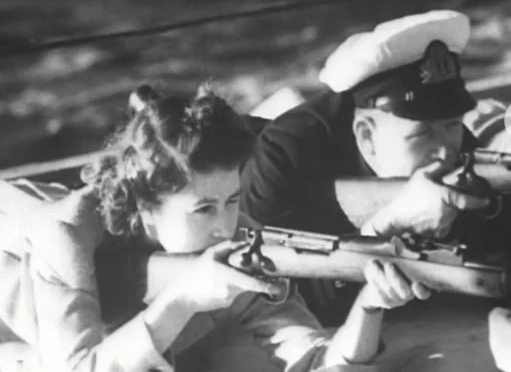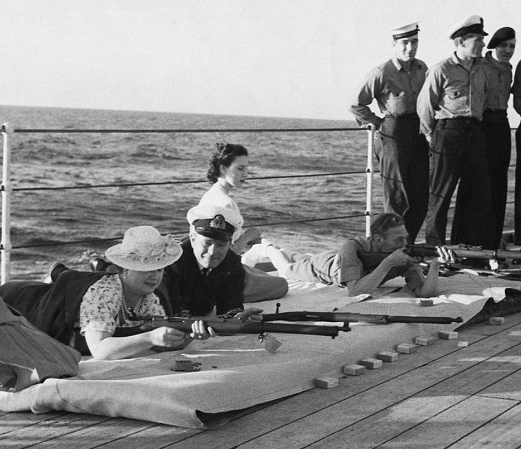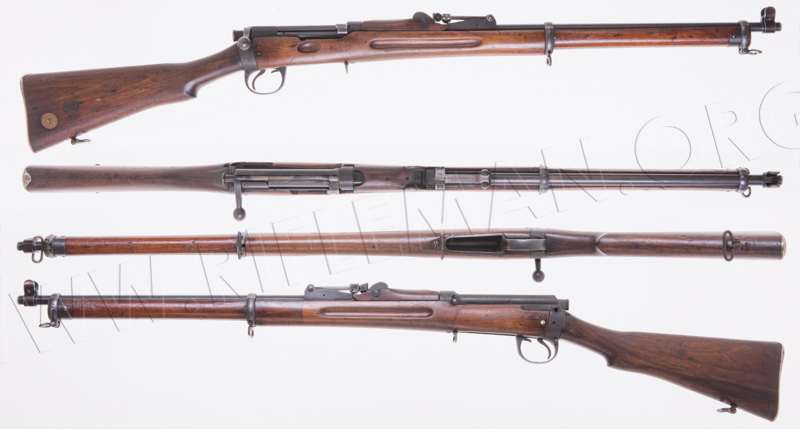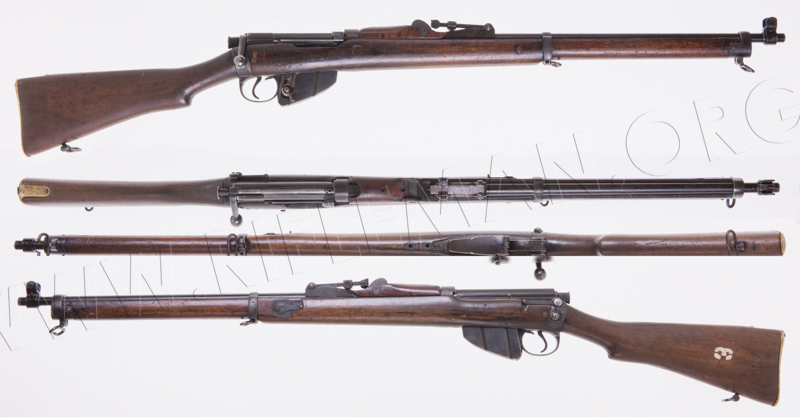The Lee-Enfield RF Short Rifles Mk.I and Mk.II
and the Hiscock-Parker 5-round training magazine
Please be aware that some specialist imagery may take time to load.
This site is designed for dedicated researchers, and is best viewed on desktop.
Hover over or Click image to bring up hi-res file
The volley sights have been removed, and the recess in the fore-end wood that held the volley fore-sight bead and dial has been filled with new wood.
The rifle is next shown with the bolt open.
It can just be seen, when zoomed, that the rifle's parent arm was a Mk.1* "Long" Lee-Enfield of 1890 manufacture at the Royal Small Arms Factory at Enfield. The tell-tale finger and hand grooves remain in the fore-end wood of the original Metford Magazine Rifle..
Hover over or Click image to bring up hi-res file
Above, the Rifle, RF Short. (Mk.I) , which was approved for service in December 1907 - without the fitment of any magazine.
The two main differences between the Mk.I and the Mk.I*, introduced in October 1911, were in the rear-sight, updated to represent that of the S.M.L.E. service rifle re-calibrated for the Mk.VII .303 ammunition, and in the vertical straightening of the curved fore-sight protector wings of the Lee-Metford Mk.I rifles to which the latter conversion was applied.
The RF Short Rifle was a conversion of various marks of the "Long" Lee-Enfield or Lee-Metford to a .22" training rifle. Issue of the Mark I commenced late in 1907, whilst the Mark I* arrived on the scene in 1912 after approval the previous year. The intention of these conversions was to provide a miniature rifle with similar weight and balance characteristics to the then newly issued Short Magazine Lee-Enfield, which was superceding the "Long Lee". As the replacement service rifle, the "S.M.L.E" was in short supply, and it was neither practical, nor economical, to convert large numbers of these for training purposes. Outgoing "Long" models, or those showing signs of wear from long service, were therefore either shortened in barrel length, then sleeved, by such as the Parkerifling system, or fitted with a solid .22" barrel. The fore-end furniture was then cut back to suit. The resulting arm then offered handling close to that of the S.M.L.E. with the economy of the miniature cartridge, which at that time was the Mk.1 cartridge hitherto used with the .22 rimfire Aiming Tube. Usually the cut-off was removed, and the rifle fitted with a magazine which had the spring and platform discarded, to receive the empty cases. This practice continued right up to the close of production of the last of the line of Lee-Enfield training rifles, the Parker-Hale conversion of the Rifle No.4, issued as the .22" Enfield Rifle N.9.
The List of Changes (L.o.C.) No. 14139 of 13th. December 1907, carried the following information on approval of the RF Short for military service.
These text-searchable documents can be viewed with vertical scrolling
or as flip-pages by clicking the appropriate icon.
Depending upon the number of pages they may take a few moments to load.
Double tap tablet or click ![]() for full page display.
for full page display.
Rifle, RF Short. Mk.II , approved for service in January 1912
Hover over or Click image to bring up hi-res file
On this example of the Mk.II the volley sights, both front and rear, remain intact.
When zoomed, the image just about shows the butt-socket markings indicating the parent rifle to have again been an Enfield produced Lee-Metford; a Mk.II of 1892 vintage. (The original "II" mark has been barred out).
Below: the rifle is shown with the bolt open.
Hover over or Click image to bring up hi-res file
 The example
shown here is a Mk.II, approved in 1912 for use by the Royal Navy. This
particular rifle is shown fitted with the Hiscock-Parker
magazine designed to offer five round magazine fire. This magazine
is a retro-fit of those originally introduced for use with the R.F.
Short Rifle Mk.III in 1915. The design was exceedingly clever, but
could not cope with hard use by recruits. It proved unreliable, difficult
to maintain and required constant attention. With care, and in the hands
of an experienced handler, it can be made to perform quite adequately.
Between 4,000 to 5,000 were manufactured before its impracticality resulted
in withdrawal. Nowadays scarce, a good example may well exceed the value
of the rifle to which it is fitted.Versions were produced both for the
'Long' Lee-Metford and Enfield, and the S.M.L.E.
The example
shown here is a Mk.II, approved in 1912 for use by the Royal Navy. This
particular rifle is shown fitted with the Hiscock-Parker
magazine designed to offer five round magazine fire. This magazine
is a retro-fit of those originally introduced for use with the R.F.
Short Rifle Mk.III in 1915. The design was exceedingly clever, but
could not cope with hard use by recruits. It proved unreliable, difficult
to maintain and required constant attention. With care, and in the hands
of an experienced handler, it can be made to perform quite adequately.
Between 4,000 to 5,000 were manufactured before its impracticality resulted
in withdrawal. Nowadays scarce, a good example may well exceed the value
of the rifle to which it is fitted.Versions were produced both for the
'Long' Lee-Metford and Enfield, and the S.M.L.E.
Below: the List of Changes entries for 1911 and 1912
giving the latest modifications to the Mk.I and Mk.I* (No.15895), and the introduction of the RF Short .22 Mark II rifle
(No.15969)
and their associated specifications.
These text-searchable documents can be viewed with vertical scrolling
or as flip-pages by clicking the appropriate icon.
Depending upon the number of pages they may take a few moments to load.
Double tap tablet or click ![]() for full page display.
for full page display.
That these rifles were in regular use comparatively recently, (in terms of the working life of rifles that are now antiques), is illustrated in film taken of the Royal Family post-WWII, in 1947, on board the last British battleship, HMS Vanguard, during time at sea when the Royals were on a tour to South Africa. One of Vanguard's 15-inch guns still stands in front of the Imperial War Museum in London (and the author of this website once sat astride one of those guns as a Naval cadet during a Summer camp on board that very ship in the 1950s).
The Gaumont News film shows the RF Short rifles, then still held on board for rifle practice, being used by the Royal Family. There is a close-up sequence of our late Queen, then Princess Elizabeth, firing one of these rifles on an informally set up range on deck.
She is also seen with the late Queen Mother, and other members of her family.
The photographs (now published as Getty images), presumably either extracted from, or taken at the same time as the filming, show the rifles in greater detail. The first image below is of Princess Elizabeth, affording close-up sight of both Her Majesty and the rear section of the rifle.
It will be noted that, although the rifles are probably Mk.IIs, the empty magazine shells are not fitted, akin to the arrangement for the Mk.I, when the fired cartridge cases simply drop through the magazine-well onto the floor of the points.

The second image is of the Queen Mother nearest (then herself Queen Elizabeth) showing the whole rifle as further confirmation of its type. The gentleman shooting at the far end of the temporary points is probably Elizabeth's father, King George VI.

E.J. Hiscock's original design for this device had his patent application granted on 2nd. January 1912.
189. Hiscock, E. J. Jan. 2.
Adapting for miniature-ammunition practice. -
Consists in a magazine for use with converted Lee-action rifles. The magazine,
shown detached in Fig. 1, comprises a casing 2 for the miniature cartridges
and a rearward extension 1 carrying a spring-pressed plunger 3 and having
an inclined upper edge. When attached to the gun by means of a plate 13,
the magazine has a limited vertical movement and is pressed upwards by
a spring 5. The breech -block, during its forward movement, first engages
the plunger 3, which pushes a cartridge into the chamber, and then engages
the inclined top edge of the part 1 and depresses the magazine, as shown
in Fig. 5, whereon the plunger 3 is released and retracted by its spring
4.
Something not generally appreciated, but R. Morris, of Morris Tube and ammunition fame, designed a magazine that significantly preceded that patented by Hiscock, and later the more sophisticated version finally patented by Hiscock and Parker together.
Morris's patent no. 16,938 of 23rd. October 1890, remarkably similar in layout to Hiscock's application drawing more than twenty years later, and particularly to the final Hiscock-Parker model, is shown below.
Messrs., Parker and the Company, as it then was, had become involved with the final design and production of the magazine. They were granted the patent on 7th. November 1913.
 25,533.
Parker & Co., A. G., and Parker, A. E. Nov. 7.
25,533.
Parker & Co., A. G., and Parker, A. E. Nov. 7.
Adapting for miniature-ammunition practice: -
Relates to magazines adapted to fit the full¬sized magazine opening
and to receive miniature ammunition, especially to the kind in which the
whole magazine is upwardly spring pressed and is automatically pushed
down by the advancing breech-bolt, as described in Specification 189/12.
The invention consists in loading the magazine through a side opening,
the top of the magazine being closed, and in providing means for holding
the cartridge-lifter depressed during the loading operation. In the construction
shown in Fig. 2, the miniaturemagazine 2 is formed at the front part of
a frame which loosely fits into the full-sized service magazine casing
1. The frame is mounted so  that it can move up and down, and is pushed
upwards by a spring 4. When the breech-bolt is moved forwards, it first
engages a plunger 17, which presses the top cartridge into the chamber,
and then engages the inclined top of the magazine and depresses the magazine
and frame against the action of the spring `4Y; -&tis releasing the
plunger 17, which is then returned by a spring. The magazine 2 is permanently
enclosed at the top and is charged through a side opening. The cartridge-lifter
3 is con¬trolled by a lever 8 which is actuated by the spring 9. The
lever 8 can be positively turned to bring the lifter 3 to its lowered
position by means of a plunger 12 and a cam 13 which is turned by an external
thumb-lever.
that it can move up and down, and is pushed
upwards by a spring 4. When the breech-bolt is moved forwards, it first
engages a plunger 17, which presses the top cartridge into the chamber,
and then engages the inclined top of the magazine and depresses the magazine
and frame against the action of the spring `4Y; -&tis releasing the
plunger 17, which is then returned by a spring. The magazine 2 is permanently
enclosed at the top and is charged through a side opening. The cartridge-lifter
3 is con¬trolled by a lever 8 which is actuated by the spring 9. The
lever 8 can be positively turned to bring the lifter 3 to its lowered
position by means of a plunger 12 and a cam 13 which is turned by an external
thumb-lever.
Further images of the magazine in actioning sequence can be found on the page for the "Long" Lee-Enfield in .22RF calibre.
The unit was approved for service in December 1917 as the " Magazine, .22" Rifle, Mk.I "

Images of magazine assembled,
............................................. and disassembled
and cutaway sketches

We are pleased to receive feedback and discussion on items shown on this site, and have already received many such enquiries.
One correspondent has suggested that the withdrawal of the Hiscock-Parker magazine from service was more likely to have been because it held only five rounds than because it was unreliable. We are by no means certain that this was not the case, but experience would suggest otherwise. It has to be said that the unit is a most ingenious piece of design, but it has a degree of complication inherent which was no doubt necessary to make it work at all.
The magazine is an exceedingly "fiddly"
device to operate. The camming and lever action used to lower the loading
platform is very stiff to rotate. The mechanical advantage here is poor.
When charging, inserting the rounds correctly is difficult. It is imperative
that rims do not come behind one another or jamming can occur. The main
spring suffers repetitive shock loading in use and could be prone to early
fracture. Careful and frequent maintenance of internal moving parts was
necessary to ensure continuing successful operation. The action of the
chamfer under the bolt head on the ramp of the magazine platform and the
feeding rod is nothing short of brutal, and wear on the ramp is significant.
If a round is not fully chambered, and the action cycled again, a jam
is almost inevitable. We have heard of no reports that a cartridge may
have been fired by the action of the feeding rod, but observation of wear
and varied shaping of its leading end suggests that a premature ex-chamber
firing in the event of a jam might not be impossible, particularly in
view of the force which is required to operate the system satisfactorily.
It does not work well for the faint-hearted! This is a feature which gives
a semblance of the full-bore action, but whether this was more by design
than necessity could be open to conjecture.
Considering that the system was intended for recruit and training use,
yet virtually required an armourer to be in attendance, it was not surprising
that it was withdrawn after barely two years in service, with only a comparatively
small number of the various marks manufactured. This was hardly an indication
of reliability. The proof of the pudding is most certainly in the eating,
and any one who has had a good taste will well appreciate its shortcomings,
which have been noted in more than one of the publications mentioning
the unit.
That the magazine only held five rounds was less likely to be a factor
in its demise, since subsequent magazines fitted to other British models
of .22" trainer almost all still held only five rounds: e.g. No's
5 and 7 as did the earlier War
Office Pattern miniature rifle. Around that time, only the
Pattern'18 ".303" cum .22" conversion by Parkers enabled
realistic operation with a full magazine equivalent. That suffered a similar
fate when attempts were made to put it into practical service use, even
though it was considerably more robust. The conveyors, not having the
pointed nose of a bullet, did not always feed reliably into the breech,
and loading them and removing the spent cases, on behalf of a number of
shooters, required additional pairs of hands on the firing point.
In July of 1918 an article appeared in the journal of the Society of Miniature Rifle Clubs (S.M.R.C.) - "The Rifleman". The piece details the arrival of the Hiscock-Parker magazine on the shooting and military training scene. It is quite comprehensive, and affords an accurate opinion of the device when new and properly utilised.
The author, with the pen-name "Carton", was a well-known military man of the day,
E.H. Robinson,
a regular contributor to the journal, with many books and training manuals published; not least of which was "Rifles and Ammunition", which he co-wrote with H. Ommundsen.
The correspondence column of a 1962 edition of Guns Review magazine
carried an interesting reply to a previous month's letter
with a query about the Hiscock-Parker magazine.
The referred to early Patent application by E.J. Hiscock in January 1912
has already been illustrated on this web page.
Further images of the magazine in actioning sequence can be found on the page for the "Long" Lee-Enfield in .22RF calibre.
WARNING: if considering purchase of one of these now rather rare and valuable magazines, bear in mind that we have seen modern reproductions, on which modern milling marks may be evidence of recent manufacture. These replicas would have been time consuming and expensive to make in themselves, and are a fascinating way of investigating and experiencing the use of this magazine, but .......................
Click here to access a Chronology of Enfield genre Training Rifles, Adapters & Cartridges
Return to: TOP of PAGE
See this website's Raison d'être




